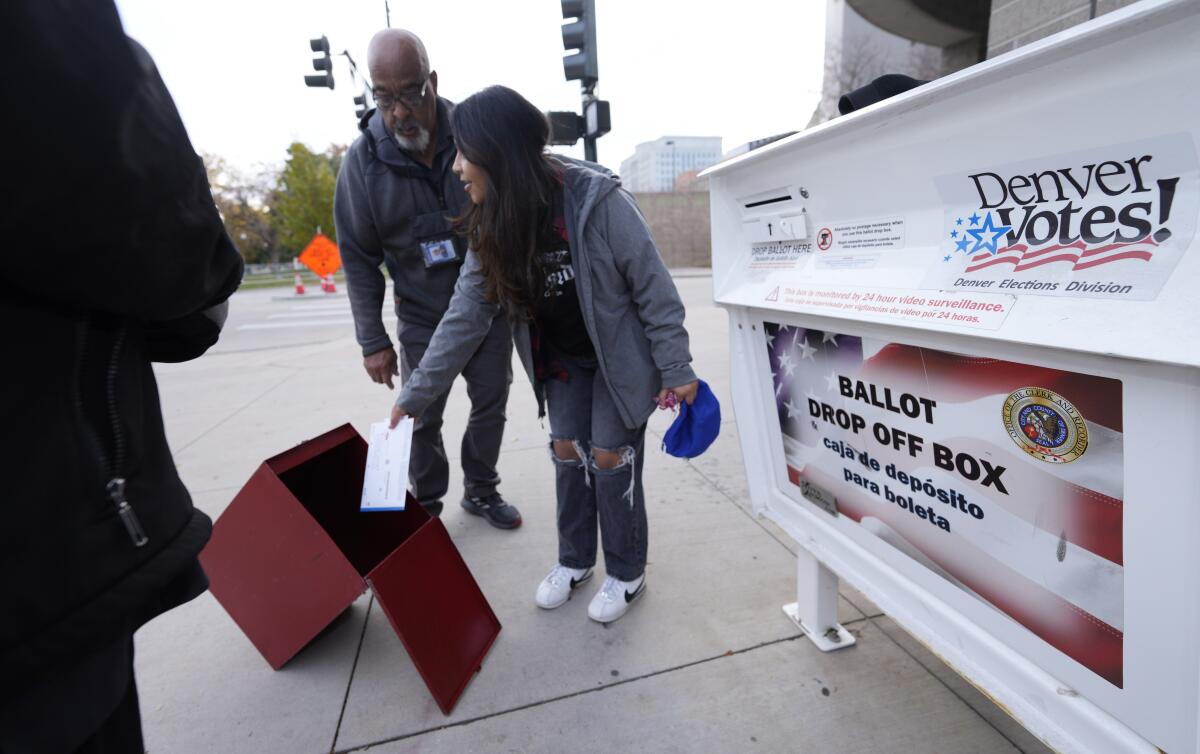Op-Ed: Gen Z’s pragmatic politics could be a key to ending polarization

- Share via
Gen Z voters have been credited with halting the predicted “red wave” in the 2022 midterm elections. These young voters turned out en masse for Democrats last week; CNN House exit polls show that 63% of Gen Zers voted for Democrats, which was a much higher percentage than for older generations. Just 43% of those over 65 voted for Democrats while 55% cast ballots for Republicans.
But this midterm outcome does not mean that voters in this new generation are dedicated Democrats. In fact, they would be better described as pragmatists and issue-oriented voters.
Gen Zers showed up at the polls in large numbers and voted in 2020 to push out Donald Trump. They engaged again this year because they wanted to take a stand against extreme positions promoted by many on the right. They turned to Democratic candidates who supported abortion rights and opposed the Trumpian movement to deny election results, and they rejected a host of extreme candidates in places like Arizona and Pennsylvania.
Can Democrats really take credit for turning out the youth vote during last week’s midterms? Or was it the Republican Party that motivated them?
At the same time, this generation largely lacks strong party attachments if we look at their political and ideological attitudes. This is made quite clear by College Pulse’s Future of Politics survey, which queried 1,552 undergraduate students at 91 colleges and universities at the start of the school year.
When asked about how they see the major political parties, today’s college students are anything but enthusiastic. Less than a quarter of all students (21%) — Democrats and Republicans included — believe that the Democratic Party is acting in the best interests of democracy and just 25% feel the same way about the GOP.
And when asked whether the parties are moving in the right or wrong direction, just 18% of all college students think that the Democratic Party is moving in the right direction; the number is a bit higher for the Republican Party. Cynicism about the parties’ future is the norm, with roughly a half of all students being pessimistic about both parties.
Interestingly, a poll released in late October by Harvard University’s Institute of Politics found that 57% of young voters aged 18-29 preferred Democratic control of Congress 57% while 31% preferred GOP control; 12% was undecided. Yet only 32% of college-age voters identify as liberal, with another 19% claiming to be conservative. The plurality of students — 48% — call themselves moderates.
The Future of Politics survey uncovers a similar breakdown with young voter party affiliation — 31% report that they are Republican and another 33% Democrat. The remainder 37% are either unaffiliated or Independent. Gen Z looks very different from those in the Silent Generation — President Biden’s and Nancy Pelosi’s generation, which has seen a decline in Independent voters and a rise in Republican identification in 2022.
In California, where competitive congressional races could determine control of Congress, young voters have the power to alter an election’s outcome.
Gallup corroborates these trends and found that younger generational groups are more likely than their older counterparts to be centrist and less partisan. Millennials appear to be fairly stable centrists, unlike earlier generations, which have become more partisan over time.
Gen Z’s lack of a strong partisan orientation, however, should not be taken as a final judgment of either party. Rather, it represents an opportunity for both parties.
America’s youngest politically active cohort is upset with the status quo. But it votes for whichever party adopts moderate positions, and whichever party adopts a pluralist path forward has a chance to win Gen Z’s support.
The Democrats did that in 2022 on a host of salient political positions, but Democrats cannot afford to move too far from the center and adopt ultra-progressive positions that will prevent coalition building with many Americans. Republicans need to move on from Trump’s big lie about the 2020 election, defense of the Jan. 6 insurrection and other fringe positions.
While it remains a question how the parties will shake out and what positions they will take going into the 2024 presidential election, what is clear is that Gen Z is shaping up to be a practical swing generation that engages politically. This tendency may help diminish the our polarization and extremism as the parties respond to this growing political power.
Samuel J. Abrams is a professor of politics at Sarah Lawrence College and a senior fellow at the American Enterprise Institute.
More to Read
A cure for the common opinion
Get thought-provoking perspectives with our weekly newsletter.
You may occasionally receive promotional content from the Los Angeles Times.












